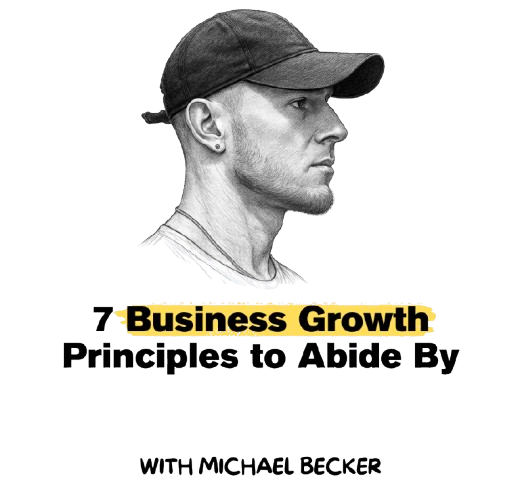Your cart is currently empty!

7 Business Growth Principles to Abide By
I have seven core “business growth values” that guide my decisions and help me stay focused when making decisions in scaling the businesses I serve.
Find them below.

1. Delay gratification. Invest in audience, content, and long-term brand equity over vanity metrics or quick cash-outs.
Founders who obsess over short-term numbers—like leads, followers, or quick revenue bursts—may be thinking about things with a short-sighted mindset. Real success comes when you delay immediate gratification and invest in something bigger.
Build your audience by consistently delivering value, and prioritize content that speaks to their needs.
Focus on developing long-term brand equity rather than getting lost in metrics that won’t matter in a year. It’s this discipline that ensures your business thrives while others come and go.
Play the long game, and the rewards will follow.
"Build trust first. Revenue is a lagging byproduct." CLICK TO TWEET
2. Dramatically overdeliver at every touchpoint. Maximize consumer surplus to encourage word-of-mouth & grow CLV.
When you dramatically overdeliver—offering more value than your customers expect—you create an undeniable consumer surplus.
This not only makes people return but also encourages them to spread the word.
Blow people’s minds at every touchpoint. Whether it’s in product quality, customer service, or post-purchase follow-ups, overdelivering generates loyalty and maximizes customer lifetime value.
3. Attention and trust compound faster than revenue. They are like gold in this new digital economy. Optimize for both.
In today’s landscape, attention is currency, and trust is its multiplier. Revenue follows attention, but it won’t stick without trust. It’s essential to understand that these two elements compound over time, and they often grow faster than your revenue numbers.
When customers trust your brand, they become long-term advocates. The foundation of sustainable growth is securing both attention and trust—and if you optimize for these, your revenue will naturally catch up.
4. Business continuity is predicated on genuinely loving customers. Anything less than a raving brand advocate is an L.
There’s a huge difference between customers who are satisfied and those who are raving fans. I’m not content with the former.
Business longevity is not built on customers who are just ‘okay’ with your product; it’s built on those who can’t stop talking about you.
To win in today’s market, your goal isn’t just sales—it’s turning every customer into an advocate. Genuine love for your customers isn’t a marketing tactic, it’s the only sustainable way to ensure your business thrives long-term.
If they’re not raving, they’re on the verge of leaving.
5. Choose to excel – not to compete. If you remain radically focused on excellence, the competition becomes irrelevant.
Competing with others is a distraction.
Instead of constantly benchmarking yourself against competitors, make your sole focus excellence.
When you deliver the best product, experience, or service possible, your competitors start to fade into the background.
Focusing on excellence allows you to innovate, stay ahead of the curve, and build something truly unmatched in the market.
Excellence makes competition irrelevant.
6. Attention has shifted toward microcontent and multimedia. Understand how to use podcasts, YouTube, and Shorts.
Consumers now gravitate towards short-form content that is easily digestible—microcontent.
Podcasts, YouTube videos, Instagram Reels, and TikTok Shorts are where attention is focused. If you don’t master these formats, you’ll struggle to keep up.
Long-form content still has its place, but leveraging multimedia, short videos, and engaging snippets will ensure that your message reaches the widest audience possible.
The brands that win are the ones who understand how to master attention across different platforms.
7. To scale, identify your constraint(s), look at the three levers of: new business volume, increasing yield, and reducing churn. Identify the weak link, fix it, then optimize the others.
Scaling isn’t about pushing harder—it’s about solving your biggest constraint.
Every business has bottlenecks, whether it’s not attracting enough new business, failing to maximize customer yield, or suffering from high churn rates. The key is to identify your biggest constraint, fix that first, and then optimize the others. Once you’ve handled your weak point, the path to growth becomes clearer.
It’s a simple but profound framework: fix what’s broken, and growth will follow.
Final Thoughts
Sustainable growth is about playing a different game—one where patience, overdelivering, and true customer obsession are your strongest moves. Don’t chase numbers. Build trust, create advocates, and fix what’s broken. When you choose excellence over competition, you stop reacting and start creating. The best businesses don’t sprint—they build momentum.
Enroll in the eLearning portal for $999 and grab my book here.

Leave a Reply